|
|
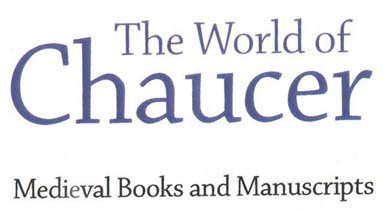
 |
Leisure, Law and Learning
Introduction to Leisure, Law and Learning
| Descriptions of books with images
A CLERK ther was of Oxenford also,
That unto logyk hadde longe ygo …
For hym was levere have at his beddes heed
Twenty bookes, clad in blak or reed,
Of Aristotle and his philosophie
Than robes riche, or fithele, or gay sautrie. |
General Prologue to The Canterbury Tales (l. 285-296)
Medieval life may have been relentless and brutal for the poor, but the
wealthier classes enjoyed a wide range of pleasures and pastimes. As
demonstrated in the evidence of this exhibition, reading was one pursuit that
could be enjoyed either for leisure or edification. Actual book ownership was
still relatively rare and confined to the elite, however, as hand written books
were expensive and time consuming to produce. Chaucer’s poetry would have been
enjoyed more frequently as oral entertainment at court rather than in private
study. More active courtly pursuits included hunting and hawking. Forests of
game were near every town and village, and knights prided themselves on their
skills both in the chase and in butchering the dead animals. The meat was a
welcome and necessary addition to the meagre winter diet. Embarking on a
pilgrimage incorporated a similar blend of practicality and amusement. Although
ostensibly a devotional exercise, it was also a popular way of taking a holiday
for all classes. Groups of pilgrims were often accompanied by hired minstrels,
so it is not hard to envisage The Canterbury Tales as actuality.
Schooling was not compulsory in the Fourteenth Century, but literacy and
learning were on the increase. There was little formal education for women, but
even remote villages might have a priest who could teach promising boys their
letters. In urban areas there were schools attached to cathedrals and larger
churches where choirboys were taught to learn to read and sing the service, like
the son of the poor widow in the Prioress’s Tale. Education was remorselessly
religious and moral: learning letters began with prayers and psalms,
increasingly in English. A thorough grounding in Latin, however, was still the
objective of grammar schools for the aspiring middle classes aiming to enter the
professions of the Church, law or medicine. After school, the sons of the
wealthy could either continue their education at University or go to one of the
Inns of Court and Chancery. In being placed as a page in a great household,
Chaucer followed another traditional route of advancement, that of ‘education by
experience’.
A good education was crucial for a career in the law. The medieval legal
system was complex and wide reaching; labyrinthine laws governed every facet of
life, from the way markets and shops conducted their business, to regulations
determining the food and clothing that each class was entitled to. Such
excessive control inevitably resulted in unrest. The laws passed in an attempt
to curb wage increases following the labour shortages brought about by plague
were one of the major contributors of the Peasants’ Revolt in 1381. The growth
of the legal and administrative system is seen in the huge numbers of charters
and other business documents that survive from the period. They are a
fascinating source for reconstructing the minutiae of daily life, and their
increasing numbers throughout the period reflect the development of a literate
mentality.
|
|
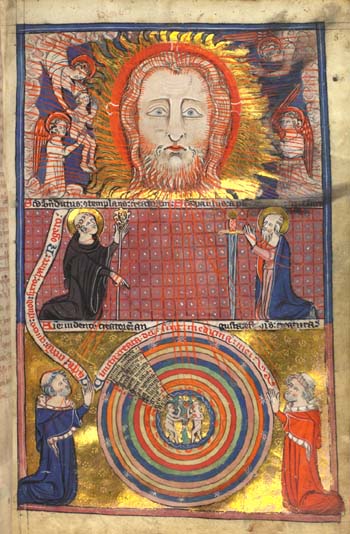
The visions of St Benedict and St Paul of God
(page 85) |
Devotional and Philosophical Writings
London: c.1325-1335
MS Hunter 231 (U.3.4)This miscellany of 38 texts includes works by Seneca, St Augustine, Anselm
and Aristotle. Lavishly produced, the manuscript is illustrated by thirteen
historiated initials and three illuminated full-page pictures by the chief
artist of the Taymouth Hours. The page displayed on the left is divided into three
compartments and depicts the visions of St Benedict and St Paul of the Creator.
At the top is portrayed the face of God, in the middle, Benedict and Paul
(positioned between heaven and earth), and at the bottom, the original owner of
the manuscript, Roger, and another figure, are shown praying on either side of a
diagram of the twelve spheres. The image of the spheres represents the medieval
view of the cosmological universe: the stationary earth is at centre – here
depicted by the Fall of Man – surrounded by the three remaining elements (water,
air and fire), the seven known planets (including the moon), and the stars.
This high quality manuscript could only have been commissioned by a person of
some wealth. In fact, Roger of Waltham (d. 1336), was a canon of St Paul’s,
London, and held the important administrative position of Keeper of the Wardrobe
of Edward II for a year in the 1320s. Roger is named as the supplicant in
several other illustrations in the book, and it may be assumed that he was
closely involved in its production.
|
|
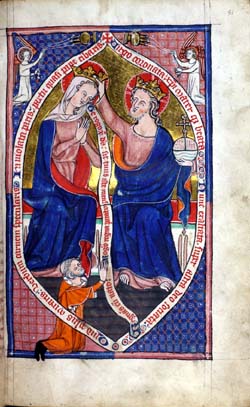
The Coronation of the Virgin (page 83) |
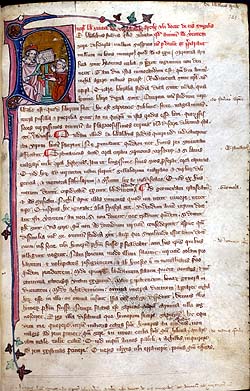
Historiated initial 'P' (page 123) |
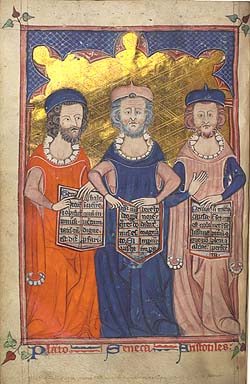
Plato, Seneca and Aristotle (page 276) |
|
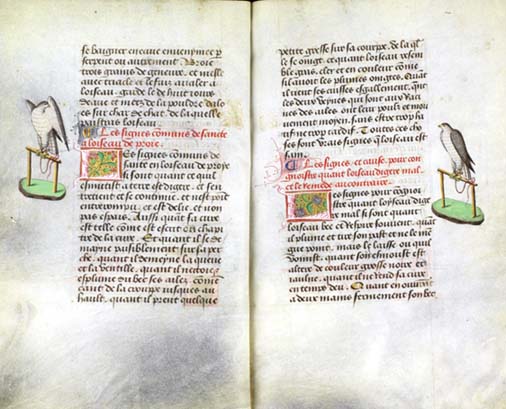
Opening with marginal illustrations of hawks (folios 27v-28r) |
Guillaume Tardif Fauconnerie and Venerie et la chasse
France: c.1494
MS Hunter 269 (U.5.9)For the medieval aristocracy, hunting with hounds or hawks was a consuming
passion. A large literature of detailed, formal handbooks describing the
procedures and rituals of hunting existed from the Thirteenth Century onwards.
This compilation on the arts of hawking and the chase is a late example,
commissioned by Charles VIII of France in around 1494. As well as engendering
practical treatises, the hunt also became a motif favoured in medieval literary
works. Although there are descriptions of hunts in the Knight’s Tale and in his
early work, The Book of the Duchess, these pursuits did not seem to interest
Chaucer overly.
Beautifully written and magnificently illustrated throughout by lifelike
pictures of birds and dogs, this manuscript demonstrates the perfection of book
design achieved in France in the late Fifteenth Century. The pages to the left are from
the falconry part of the work, displaying a section detailing the signs of
health and sickness in birds of prey. Hawks were prone to endless ailments and
much of the falconer’s skill lay in maintaining the condition of the birds.
Descriptions of ailments and medications usually form substantial sections of
the medieval treatises on the art.
|
|
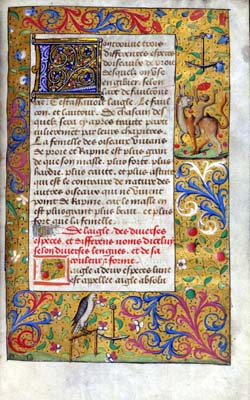
Beginning of Falconry part (folio 6r) |
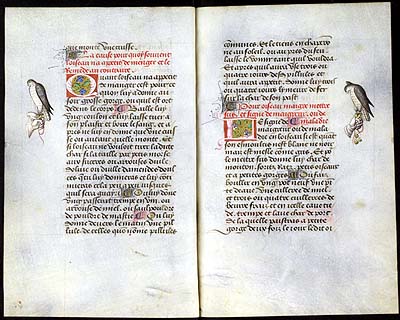
Illustrated pages from Falconry part (folios
30v - 31r) |
|
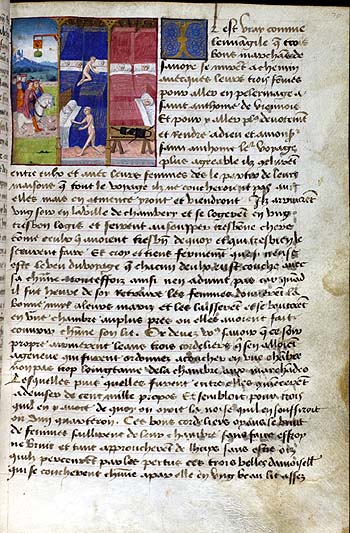
Beginning of tale 30, the three friars (folio 70r) |
Les Cent Nouvelles Nouvelles
France: c.1475-1500
MS Hunter 252 (U.4.10)Like The Canterbury Tales, this collection of one hundred burlesque and
licentious tales is given coherence by its narrative framework. Modelled on
Boccaccio's Decameron, in this case the stories are recounted by various members
of the Burgundian court. The work was presented to Philip, Duke of Burgundy, at
some time in the late 1460s; its authorship is unknown. This volume is the only
surviving manuscript copy of the text.
Each of the tales is introduced by a lively miniature, illustrating scenes of
domestic and intimate life in provincial medieval France. The story shown here
is that of the three friars, in which three merchants and their wives set off on
a pilgrimage. The couples agree to underline their devout purpose by sleeping
apart in separate rooms on their journey. Inevitably, three lusty friars creep
into the beds of the women under cover of darkness and cuckold the husbands.
When the wives berate their husbands for not keeping their promise of
continence, the husbands realize what has happened and, to prevent their wives
embarrassment, pretend that it was them all along. For the rest of the journey,
the couples sleep together. The three-part miniature here depicts the pilgrims
arriving at the inn for the night, the friars (clearly tonsured) sneaking into
the beds of the wives, and the husbands obliviously sleeping alone.
|
|
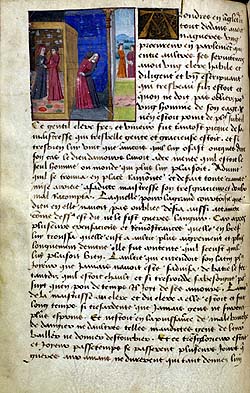
Tale 13: the eunuch clerk (folio 27v) |
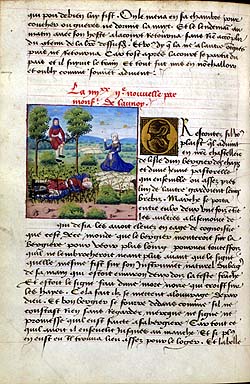
Tale 82: the limit (folio 172v) |
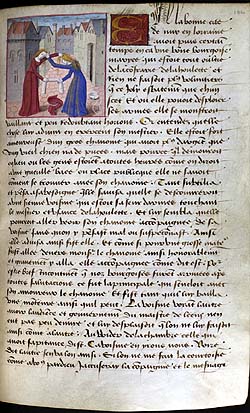
Tale 92: King Rex's prisoners (folio 186r) |
|
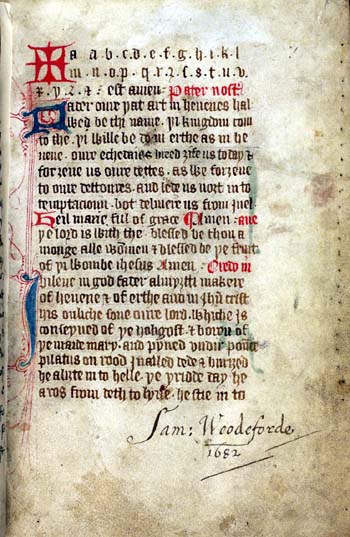
Beginning of text with ‘ABC’ (folio 1r) |
Primer
England: late Fourteenth Century
MS Hunter 472 (V.6.22)This fourteenth-century prayer book, or primer, was probably written for a
young person who had to learn to read from it. It opens with the Latin alphabet,
Christianized with a cross at the beginning and ‘amen’ at the end. It is
followed by the Lord’s Prayer, the Hail Mary and the Creed (the essentials of
belief). The linking of the ABC and prayer marks an elementary stage of
teaching. It is estimated that by the end of the Fifteenth Century perhaps half
the population could read English – although this literacy may only have
extended as far as an ability to recognize words from the most familiar prayers
and psalms. A marginal annotation from a sixteenth-century reader states that
this manuscript is a good and profitable book ‘for a man that can not understond
Latyn’.
Preceding the opening of the text, the flyleaves have been utilized by a
fifteenth-century reader to copy out further prayers. Several contemporary notes
are found in the calendar section of the manuscript: the earthquake of 1382 is
noted at the entry for 21st May while the coronation of King Richard of 1377 is
marked at July 15th. At the foot of the first page of text is the autograph of
the seventeenth century poet, divine and Canon of Chichester, Samuel Woodford
(1636-1700).
|
|
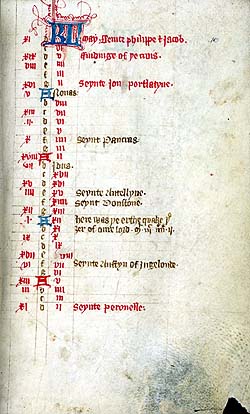
Calendar page for May (folio 10r) |
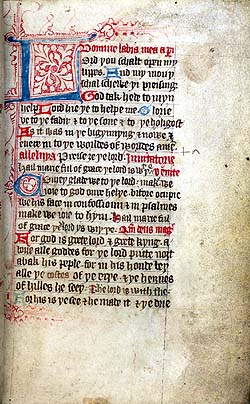
Opening of prayers for matins (folio 14r) |
|
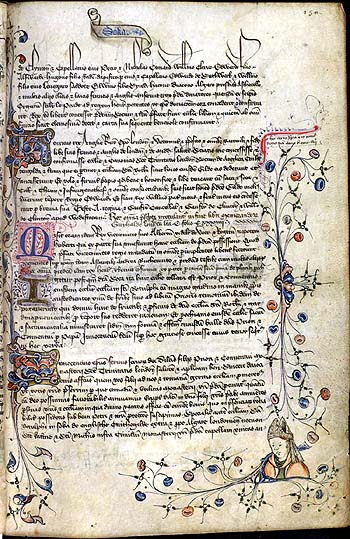
Illuminated page from section concerning the ‘Soca extra Algate’
(folio 150r) |
Aldgate Cartulary
London: 1425-1427
MS Hunter 215 (U.2.6)A cartulary is a collection of those administrative documents that are
loosely referred to as 'charters'. Those gathered here all relate to the
business of the Augustinian priory of the Holy Trinity in Aldgate in London.
Founded in 1108, this important monastic house had interests in some 87 London
parishes, gaining much of its income from owning properties, selling land in
which fixed annual rents were retained, and collecting quit rents. This volume,
containing over a thousand documents, provides a detailed record of the social
and economic life of medieval London, and of its topography and changing land
use. Chaucer’s parents are amongst those listed as paying rent. Chaucer himself
lived above the city gate of Aldgate during the 1370s. He paid no rent for his
dwelling, which was obtained as result of his post as Controller of Customs.
Although primarily a pragmatic document, this manuscript is a professional
and fairly sumptuous production; many of its pages are adorned by richly gilt
and flourishing initials. An opening at the beginning of the section relating to
the ‘Soca extra Algate’ is displayed here. As well being enhanced by painted
initials and ornamental floral sprays, there is a tinted drawing of a mitred
ecclesiastic: this is probably purely decorative and cannot be regarded as
representing anybody.
For more information (with further images) about this book, see the
August 2002 book of the month article
featuring it.
|
|
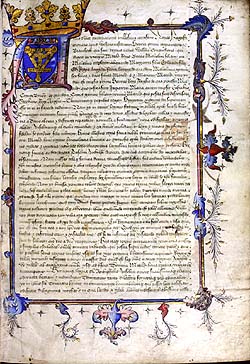
Opening page (folio 1r) |
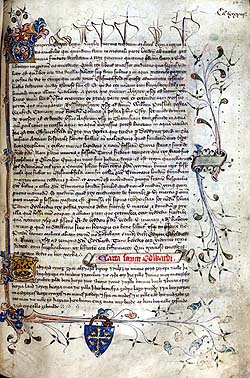
Beginning of section concerning the ‘Soca extra
Algate’ (folio 149r) |
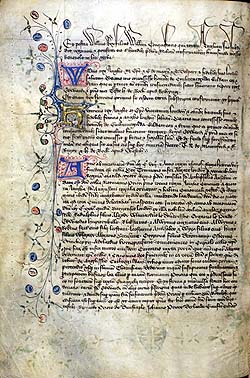
Continuation of section concerning the ‘Soca extra
Algate’ (folio 149v) |
|
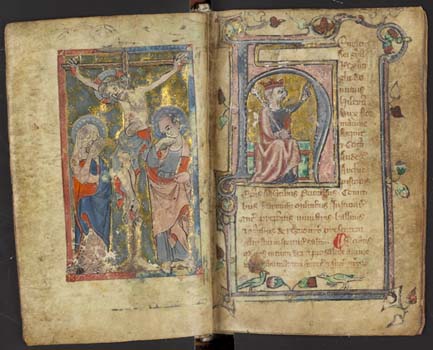
Opening with illustrations of the Crucifixion and an enthroned king
(folios 9v-10r) |
Statutes of the realm
England: Fourteenth Century (first half)
MS Gen 336This pocket copy of the laws of England was probably written for an itinerant
lawyer. The collection is prefaced by two illuminated pages depicting a
Crucifixion and an image of an enthroned king: the conjunction of Church and
state. The text opens with Magna Carta, the great charter of 1215 in which King
John – under considerable pressure from his barons - placed himself and
England's future sovereigns and magistrates within the rule of law. The version
here copies the third re-issue of the charter by Henry III, made in 1225.
The manuscript is written in a mixture of Latin and French and amongst the
other statutes included is a copy of Henry II’s ‘Charter of the Forest’ granting
earls and barons the privilege to hunt in the royal forests. The last statute
entered (as an addition) dates from the early 1350s, some ten years before
Edward III ordered that the use of French in the courts should be discontinued
because people could not understand it. Parliament opened in English for the
first time in 1363.
|
|
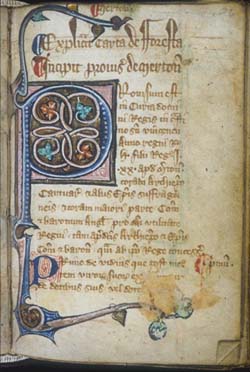
Page with decorated initial (folio 26r) |
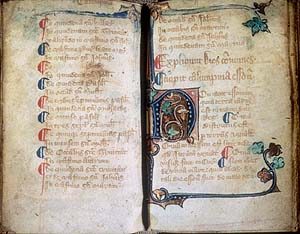
Opening with decorated page (folios 194v - 195r) |
|
|